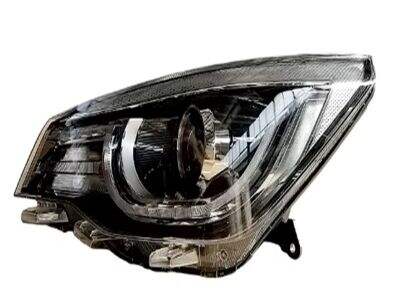Car headlight types: When it comes to car headlights, there are three major types: Halogen, LED, and HID. There are many features that are unique to each type of headlight, which is why they have become quite common among the different drivers. Understanding these differences is critical so that you can select proper headlights for your car. Now, let us take a closer look at how Halogen, LED, and HID Autó fényszórók work what the key differences are between each.
How Bright Are Halogen, LED and HID Headlights?
Halogen headlights have been around for a while and are still commonly used in vehicles. They emit a warm yellow light that a lot of people are familiar with. Halogen lights do a good job of lighting the road in front of you, but they aren't as bright as LED or HID headlights. In contrast, LED headlights emit a bright white light that closely resembles natural sunlight. This bright light is one of the reasons why most drivers love led lámpák autók fényszóróihoz especially for night driving or bad weather as visibility is a factor. HID (High-Intensity Discharge) headlights, or xenon headlights, are the shiniest of the three. The light they produce is more of a white because it's blue-white, which means it helps people to see the road better as well to see what's ahead of them, which is very effective for driving in darkness.
How Much Power Do Headlights Use: Halogen vs. LED vs. HID
There’s a few things we look at energy use, Halogen headlights are the most power usage. They require so much power in order to create their light and can harm your car's battery, especially if you run them for longer than a minute or two. Conversely, LED headlights are extremely energy efficient. They consume significantly less power than Halogen headlights, which can also help enhance your car fuel economy. This allows your car to travel farther on a tank of gas. HID automata fényszórók are in the middle of the two, using a moderate amount of energy for the bright light they produce.
So, Which Type of Headlight Has the Longest Life?
Let's take a look at how long these headlights last to see what we find out. Halogen headlights have the lowest lifespan out of the three. They have a lifespans of about 450 to 1,000 hours of operation, so they need to be replaced relatively often. This may not be very convenient for the drivers. LED headlights have excellent longevity up to 50,000 hours or more. This long lifespan also means you won’t need to change them out as often, which makes them a great option. HID headlights fall in between at about 2,000 to 3,000 hours on average. This means that overall LED headlights are the most durable type of headlight compared to Halogen and Xenon.
What Color are Halogen, LED, and HID Headlights?
As we have discussed, Halogen headlights burn a warm yellow tone that feels cozy, but not so great when it comes to seeing clearly at night. LED headlights give off bright white light that is somewhat similar to natural sunlight, a feature many drivers find useful in relation to visibility. That makes them an ideal option for driving at night. HID headlights emit a blue-white color they prefer because they can see in the dark and realizing fogs much better. The tint of the light can also make a significant difference between how well the drivers could see the road as well as the obstacles.

 EN
EN
 AR
AR BG
BG CS
CS DA
DA NL
NL FI
FI FR
FR DE
DE EL
EL HI
HI IT
IT JA
JA KO
KO NO
NO PL
PL PT
PT RO
RO RU
RU ES
ES SV
SV ID
ID UK
UK VI
VI SQ
SQ ET
ET HU
HU TH
TH TR
TR FA
FA AF
AF MS
MS MK
MK KA
KA BN
BN NE
NE KK
KK SI
SI UZ
UZ KY
KY